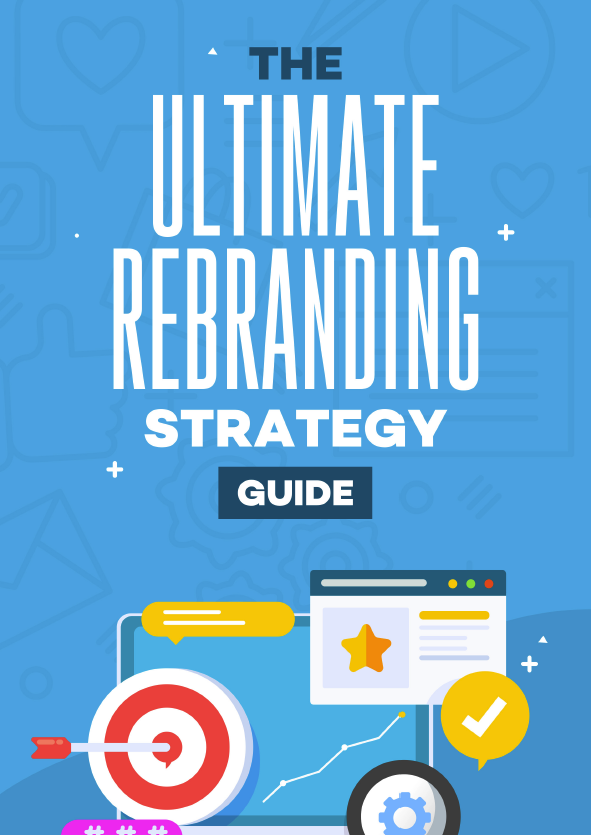“If you want to sell, you’ve got to write copy well.”
If you’re new to the business world, you probably just groaned as you read that and thought, “I have to write to run a business? I’m an awful writer. And what’s copy anyway?”
No matter who you are, sitting down to write can feel like putting on armor to go into a battle – one between you and that horrible, white screen and annoying, blinking little cursor. Worse, if you think you’re not a naturally “gifted” writer (whatever that means), writing becomes that much more of a struggle.
If you relate to this, here are two things you need to know:
- You’re not a bad writer. Why? There’s no such thing as a “bad” writer, just a writer without the right tools.
- What’s copy, you ask? Well, that’s why we’re here!
Breaking It Down
Whether you’re a small business owner, self-employed, or someone who wants to create engaging content and grow an online following, you need to know what copy is.
First, there’s a difference between content and copy.
Content is probably what comes to mind when you think of writing – long, factual, informative text. It’s useful for when you want to educate people about things, like a product description or this blog 😉 It tells your audience who you are and showcases your value without pushing them to any particular action other than building the relationship between business and consumer.
Copy has an ulterior motive – a goal…
Copy is text that gets your audience to think, feel, or act a certain way to ultimately sell your product.
Like content, copy provides information, but in a way that changes beliefs or gets people to take action – or both! Not only can it tell people about a product or service, but it motivates them to buy your product, subscribe to your service, sign up for your newsletter, or whatever else you want people to do.
A Crash Course on Types of Copy
Back in the old days (i.e. before the internet), copy mostly consisted of direct mail, newsletters, ads in newspapers – print ads, essentially.
Today, copy comes in loads of forms – here are the 5 most common types:
- Marketing
- Social Media
- Brand Copy
- Direct Response Copy
- Email Copy
Copywriting is everywhere in how a business interacts with their market because it’s super versatile and super good at selling.
1. Marketing Copy
Marketing copy is any form of sales-driven content – and I mean any. This is probably what you are most familiar with since you’ll find this in…
- YouTube ads
- Direct mail
- Online ads
- Branded stickers
- Billboards
And the list goes on.
Marketing copy has a clear goal of trying to sell.
For example, if you want to announce a new product to potential customers, you’ll probably use some form of this.
Let’s look at an example from Going.com.

With limited text and a sleek design, its messaging is clear. Going.com wants you to use
their website to book your flights.
The use of big, bold, two-toned text forces eyeballs right where the company want them
to look. The bright green call-to-action button (“CTA”, more on this later) is impossible to miss.
2. Social Media Copy
Social media is an influential way for companies to talk directly with their audience by presenting themselves as personal, relatable, and even approachable.
Here’s an example:

Entrepreneur Ali Abdaal’s tweet is simple and to the point – an effective strategy to quickly connect with people who are scrolling fast.
The first sentence hooks you. Immediately, you trust this guy’s intelligence for him to get ranked top student at an elite university. You want to be smart like him. If he’s offering tips on how to get there, you’re sure to follow the link.
After engaging you with 14 valuable study tips, he asks for a further step at the end of his thread, checking out his YouTube. He proves himself first, then asks for more engagement off-site.
3. Brand Copy
Just like logos, fonts, and other design elements communicate a brand’s identity, brand copy showcases who your company is in snapshots.
Let’s compare the copy between two brands.
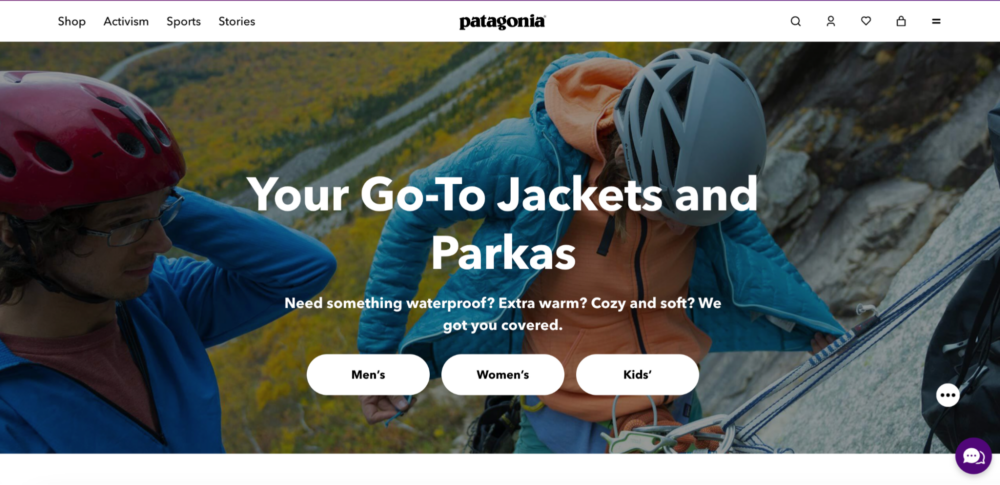
Patagonia’s copy is down to earth, relatable, and assumes a diverse target audience. Patagonia knows they’re marketing to outdoorsy people who have a variety of different needs based on whether they’re hikers, runners, bikers, etc. That’s why they say “Whatever you need, we got you covered.”

Carhartt, on the other hand, has a different target audience. They sell workwear, so they know their audience has different concerns for clothes. They use words like “tough” and “durable” in addition to “comfort.” Even as their popularity as streetwear has grown, their brand identity is sharing the story of hardworking people.
Both brands know who they are, and who they’re for. And their brand copy showcases that.
4. Direct Response Copy
This is copy with a straight-to-the-point, clear CTA, such as:
- Pop-ups
- Emails
- Limited-time offers
- Promotions
When companies want potential customers to jump to action fast, they use direct response copywriting. They make it as easy as possible for people to take a step.
Here’s an example of how:
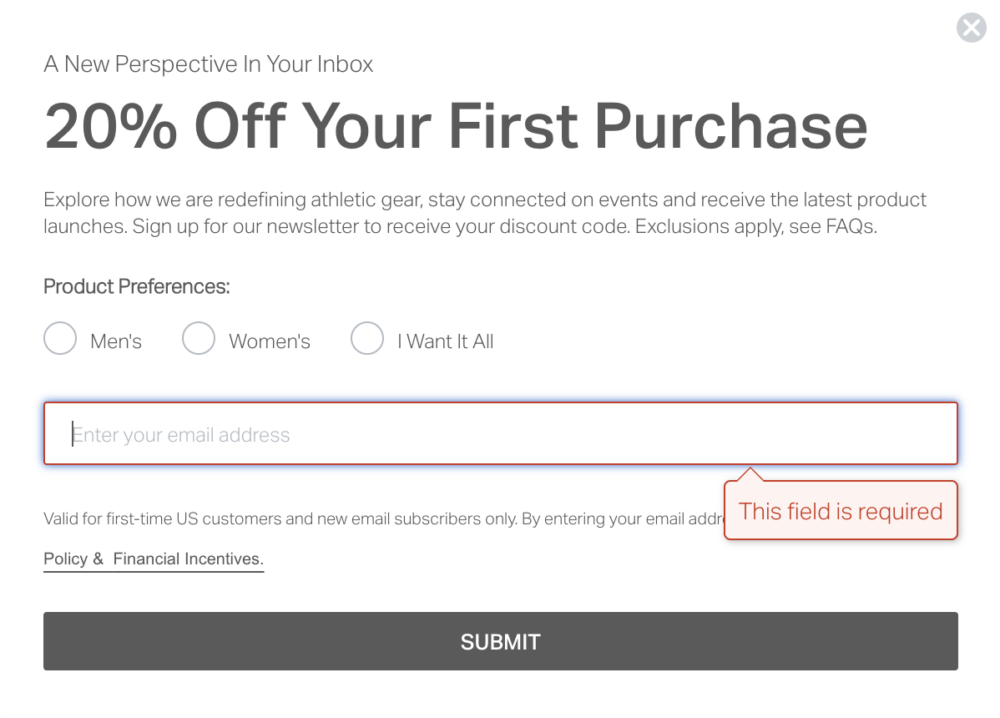
This is an immediate pop-up from activewear Vuori’s homepage.
Vuori makes it easy for visitors to sign up. This pop-up is automatic, and without moving a muscle, the cursor already blinks in the highlighted email box. The large black “20% Off” text makes the deal obvious.
5. Email Copy
Finally, companies send out emails to motivate the recipient to action. This is a crazy effective tool. After someone gives a company their email (from a pop-up box), the company sends emails with engaging subject lines, information, and clear calls-to-action.
There are probably examples galore in your inbox, but just in case here’s a good one:

This is an old, old email from Twitter (now X), but the premise is still the same. Effective emails don’t have blocky text, often use bullet points, can be informational, and provide links to their website.
The Must-Haves for WOW-Worthy Copy
Now you know how copywriting is different from content writing (it sells), and you’re familiar with the common types of copywriting. But as a beginner copywriter you need to know what makes good copywriting, well, good.
These are the crucial components of writing good copy.
Intriguing Headlines:
Don’t be fooled into thinking the bulk of your time will be spent on body content. 99% of the time, this isn’t true – it will be spent on crafting a good headline.
Your headline is the single most valuable bit of copy. Headlines make or break whether people click on your website, blog, or video – so spend some time here.
Why Headlines are Critical – They Determine…
- If people click on you
- If they stay on your page
- And ultimately, if you make money.
Have I said headlines matter yet?
What’s both tricky and helpful about headlines is they consist of just a few words – but the words have work to do, including:
- Intrigue your audience
- Match their expectations + what they hope to find
- Mirror the rest of the content (can’t be bogus or random)
- Show off what they’ll gain by reading it
Copy Wiz Joanne Wiebe’s 7 Attention-Grabbing Tips:
(From Headlines, Subheads, & Value Propositions)
- Use a quote
- Make a claim that’s almost unbelievable
- Give a time limit
- Crush an objection
- Be unexpected
- Tap into something visceral
- Use trigger words
(Adjective) Subheads:
If there is one thing people don’t want, it’s their time to be wasted. People want to know a bit more about what they’re getting into to see if what you’ve got is worth their while. Subheads provide an important clue about what they’ll find on the page.
If the headline’s goal is grabbing attention, the subhead’s goal is to keep people on the page.
Subheads function in 2 ways:
- They are the text below a headline that supports it.
- They are small headlines that announce sections of body content.
Here’s an example of a heading-supporting subhead:

Pulled from HelpGuide.org, this shows how headlines and subheads work together. The headline is simple – just two words, but it tells readers the article’s theme.
The subhead gives a bit more information – which people want. HelpGuide.org knows people are tired of all the confusing, conflicting diet advice. The subhead recognizes people’s confusion, promising an easy read and clear tips.
Subheads make it so readers know what they’re getting into – before they have even started reading.
Calls To Action
We keep mentioning this, but what exactly is a call to action?
A Call To Action (CTA) is a way for readers to take the next step, such as –
- Signing up for newsletters
- Making a purchase
- Clicking a link for a free download
- Subscribing to a YouTube channel
And much more.
This is a vital part of copy – make sure you always include a CTA – otherwise, what is the copy for? Then it would just be content. And, make sure your CTA is clear.
How to use CTAs:
- Make it your whole point (think pop-ups, subscription boxes)
- Use it to wrap up your copy (think links in direct emails, longform ads, blogs)
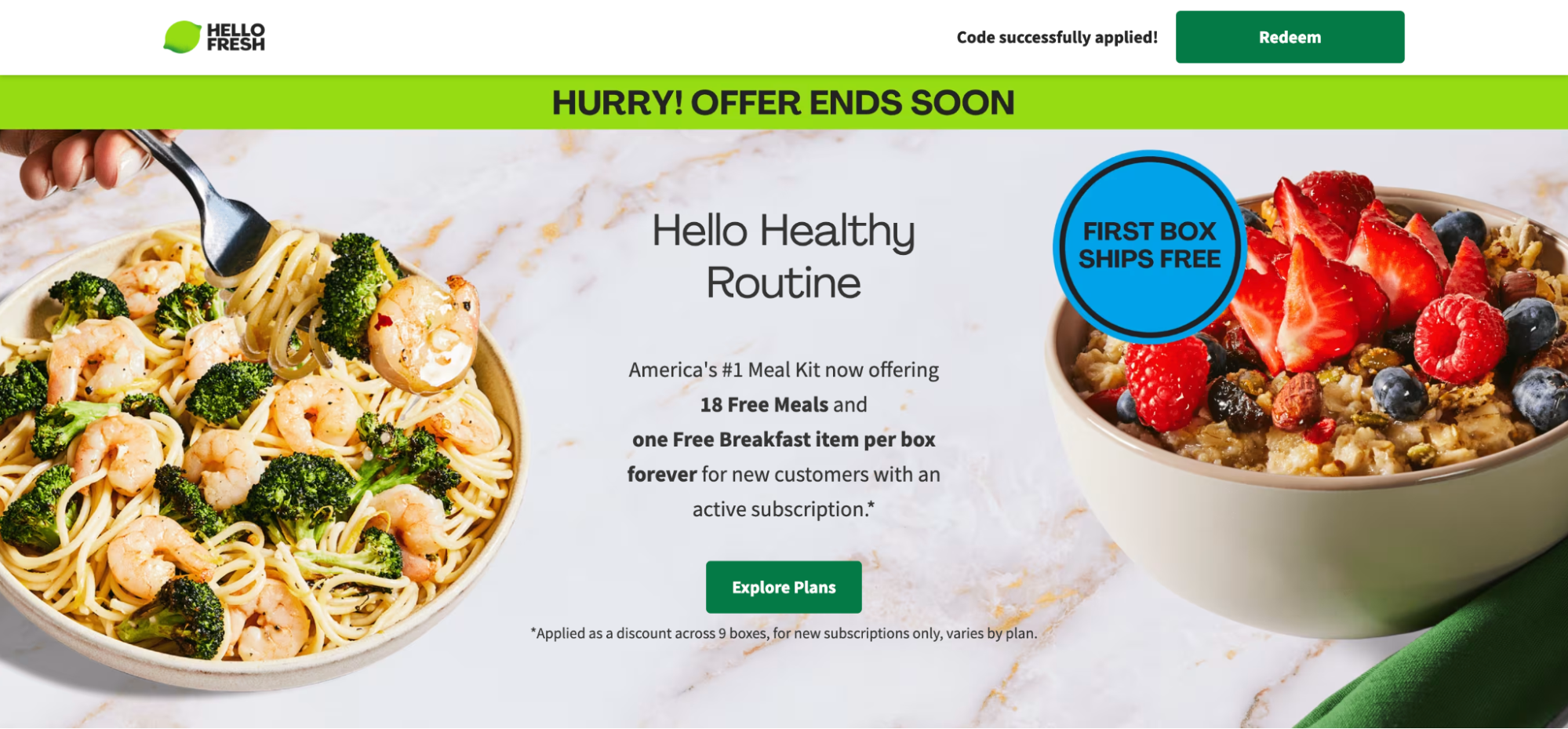
HelloFresh’s example below shows a banner with a clear CTA. The bright green top banner with bold “HURRY! OFFER ENDS SOON” urges the audience to act – and fast. With the two images on either side of the text, our eyes are funneled towards the CTA (the green “Explore Plans” box).
In case we miss this, there is another CTA at the top of the screen. Lots of ways to take action!
Formulas to Make Your Life Easier
There’s science to learning copywriting.
For all copy, you want to transform your readers. Remember that in your copy, you want readers to move
from X state -> Y state (Y being better than X)
and you’ve got what it takes to get readers to Y.
Whether it’s emails, blog posts, social media ads, or videos, all good copywriting follows some kind of formula based on what hooks the readers’ attention, keeps their eyes on the page, and ultimately completes the call to action.
These formulas are easy to follow and help you tons when you sit down to write copy. Not only will you write great copy with these, but you’ll also write faster.
Here are 4 great formulas for general copywriting:
1. PAS
P – Problem (What problem readers feel)
A – Agitation (Inflame this problem, make them really feel it)
S – Solution (Provide your solution to relieve their problem)
This formula is fantastic to use for 2 reasons – it’s highly effective, and it’s super versatile. If you’re in a pinch or need to A/B test a few different ads, this is a great go-to formula.
Start with your target market’s problem – make it BIG. Tell a story, make your readers feel seen, and think “Hey, I feel that too!”
Then, agitate that problem. Poke at it until it hurts. How? Think of how that problem shows up in their bank account, life, mirror, gym, drive to work, etc. Make your readers uncomfortable, because…
Your product provides them relief from that problem. It’s the solution.
2. AIDA
A – Attention (Hook your readers right away)
I – Interest (Build up their interest and curiosity – keep them reading)
D – Desire (What do your readers want? To work faster, to be fitter than
their neighbor, to have more time to relax? Lean into this)
A – Action (End with a CTA)
Another great formula for most all copy.
Simple, clean, effective – and there are lots of ways you can modify it, such as in the next formula:
3. AIDPPC
A – Attention
I – Interest
D – Description (Of the problem, the solution, agitate the problem, etc.)
P – Persuasion (Use visceral words, appeal to their ego, tell a story, etc.)
P – Proof (How you can solve it, make yourself credible)
C – Close
This is AIDA if you were to unpack Desire into 3 steps.
After you’ve hooked readers, really flesh out the problem or solutions to the problem. Then use your persuasive skills. Add to this by providing proof through testimonials, endorsements, influencers, etc. that your solution has what it takes to solve their problem.
Finally, close it with a CTA.
4. PAPA
P – Problem
A – Advantages (What the gain from solving the problem)
P – Proof
A – Action
What’s so great about this formula is that it gives you a spot to establish your credibility. This is where you can use customer testimonials, share your professional success + background, how much research you put into your product, etc.
You guessed it! As always, end with a clear CTA.
Essential Skills and Best Resources
Now that you’ve got some handy dandy formulas to use, what are the most important skills and resources you’ll need to be a copywriter who wows?
Research, research, research.
I know. It’s not glamorous. But it is super necessary. In fact, the more research you do before you write, the less time you’ll actually have to spend writing.
How to research:
- Spend some time with your audience. Get to know them. What videos do they watch? What websites/online figures do they turn to for advice? What problems do they feel?
- Talk to them. Interview them if you can! At least, you should send them simple polls through emails or pop-up ads on websites. Let them tell you what they want or how you can provide them with better service.
- To find your testimonials or problems, look at reviews. Find product and service reviews on Amazon or Google. Often, you can find useful testimonials that you can paste right into your own copy.
- Look at what your competition is doing. Snoop around their websites, blogs, emails, etc., to find what’s useful.
- Sign up for newsletters from people who sell well. Think big business, popular brands, influencers, etc. Kind of like the one above, this is a way for you to see what works and use it!
If your first draft is crappy – good!
Don’t let a “bad” first draft stop you – especially if you’re a beginner or small-business copywriter. That’s what first drafts are for – flushing out all of the bad to find the hidden nuggets of gold.
When writing a first draft – make it SUPER over-the-top. Go all out with the cringey, cheesy, used-car-salesman language. It’s better to start big and rein it in than expanding on what you’ve got.
You’re trying to sell, remember?!
Use wisdom from Copy Geniuses.
There are tons of highly talented copywriters oozing helpful tools and tricks that you can use. Here’s just a few with great info on copywriting for beginners.
Want to Sell? Use these 7 Tips
Embrace your niche-ness.
Don’t please the masses. Pleasing everyone means pleasing no one. If you try to make copy that will hit home with everyone, you will write very, very bland copy. And bland copy won’t sell.
The more details + specifics you use, the more excited your target audience will be. And if they’re excited, they’ll be more likely to buy from you.
Know (and I mean know) your audience.
Continuing Point 1, your audience should feel like you can see inside them. You know (in detail) their pesky problems, deepest fears, secret desires, and big dreams. And best of all, you know how to get them there.
Format your copy well.
Your audience is not sitting down to view your copy with a nice, steamy mug of hot chocolate and a fuzzy blanket.
In other words, they’re not going to read your copy, they’re going to scan it.
Format your copy to be skim-able by making things as easy as possible for your readers.
- Bold + big headlines and subheads. Readers will glance over your text to see if it’s worth their time. Use subheads to throw out bits of info lying in your copy.
- Break up text, unless you want to turn off readers. Which you don’t. Big text chunks scream unreadable. Break up text into nice little segments, no more than 4-5 lines max.
- Use bullet points to make, well, points. If you’re listing out reasons why readers should do something, break it up into points. When readers skim the page, they’ll thank you for giving them fast info.
- Get to love symbols. Make symbols your new best friend. Symbols are much more eye-catching and recognizable than letters (especially when used in longer text-based content).
- 3, not “Three”. Avoid spelling out numbers.
- Instead of “and”, use an ampersand (&) or plus sign (+)
- Use …, — , and ( ), even in spots where it’s not 100% necessary.
- Use relevant, striking images + graphics. Pictures say 1,000 words. Images and graphics will give readers’ eyes a break, and again, you want your copy to be easily digestible.
- Be up-to-date, but not “trendy”. Nobody wants to read stale copy. Look at what’s popular now, but be wary of coming off as “trendy.” Trends come and go faster than we can imagine. If you’re going to tap into a trend, make sure that trend is still, well, trendy.
If it doesn’t work – try, try again
Don’t be downtrodden if your first bit of copy doesn’t land as well as you had hoped. This is your chance to reach out to your audience! Through simple polls or reviews, ask them what worked or what didn’t work.
And keep on trying.
Next-Level Copywriting Skills
Once you feel comfortable with the basics of copywriting, you can begin to enhance skills to become a highly valuable copywriter.
Get to know the science
We know when we come across an advertisement that’s compelling, but sometimes we don’t always know what it is that moves us to trust the brand, buy the product, or just keep coming back year after year.
Emotions are powerful
To persuade, you have to pull out the right emotions in your audience. You’ve got to know what their emotional triggers are – problems, insecurities, fears, etc (this is partly why it’s so important to know your audience well).
Emotional appeals lead to high conversion rates.One of the best ways to do this is through visceral language. Use trigger words like secret, proven, miserable, bitter, and charm all evoke strong emotions.
-> Bonus: the psychology of Loss Aversion reveals pain is 2x more powerful than gain!
Let your audience do the talking
Testimonials are a fabulous way to establish credibility and trust with your audience. Even if you’re just starting out, pulling testimonials from reviews and putting them in quotation marks will tell readers that you’re just like them – you are worthy of their trust. Better yet, if you do have true testimonials
Test It Out!
This is your chance to play around with what you create! If you’re launching an ad to promote a new product, A/B test a few different ads to see which ones are converting better. Copywriting is a learning process, and you can’t learn unless you know how you perform.
Climb The Ranks
To boost search engine rank, companies will sprinkle in common keywords in their copy on landing pages or in blogs. This is called Search Engine Optimization (SEO). So, when people Google something relating to your service or product, your website will move up higher on the list since it will get recognized by the search engine as relevant. This means more clicks, more eyes on you, and more chances to sell.
- Tip: to find what keywords people commonly search for related to your product, use Google’s search bar. Start typing in words related to your product and see what comes up first.
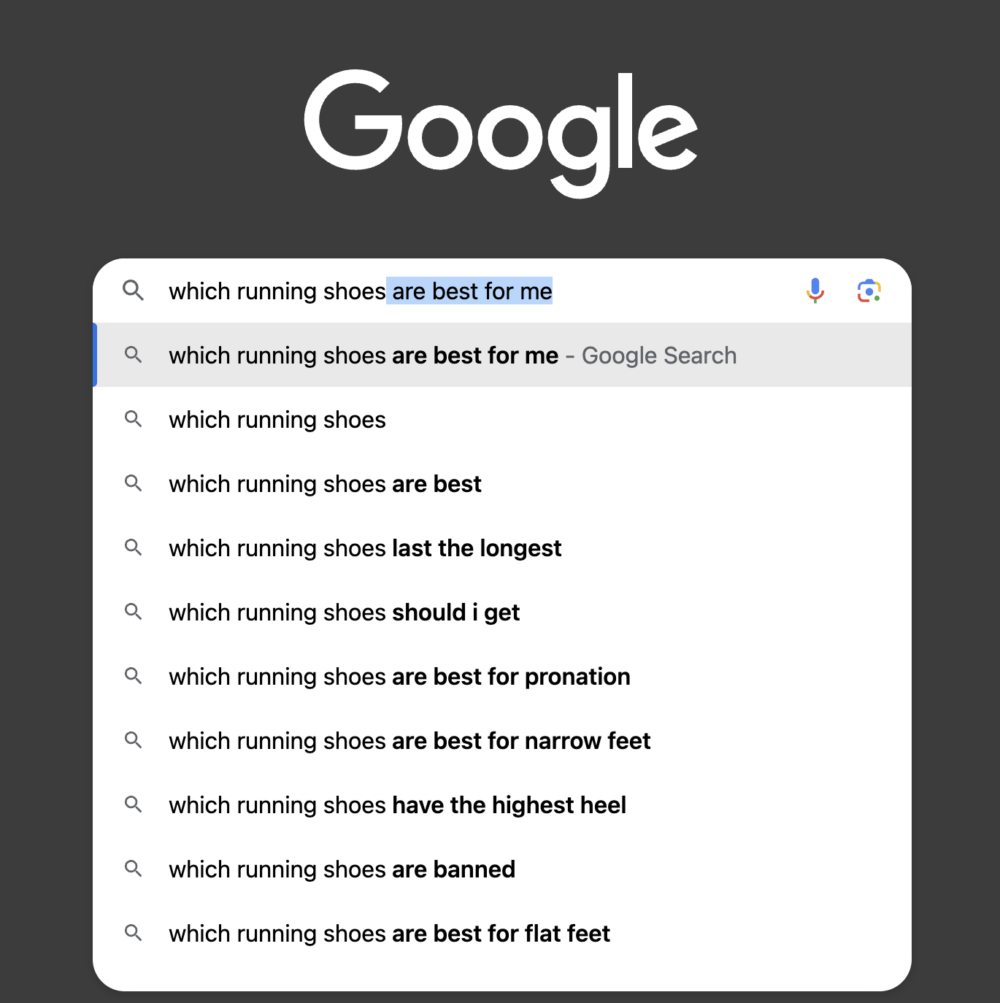
Wrapping Up
Congratulations!! You’ve made it through our crash course on the basics of copywriting for beginners.
To recap, you learned:
- What copy is (and how its different from content)
- Different types of copy
- Must-haves for good copy
- Formulas to use
- Skills to hone and resources to use…
- And how to take your writing to the next level

